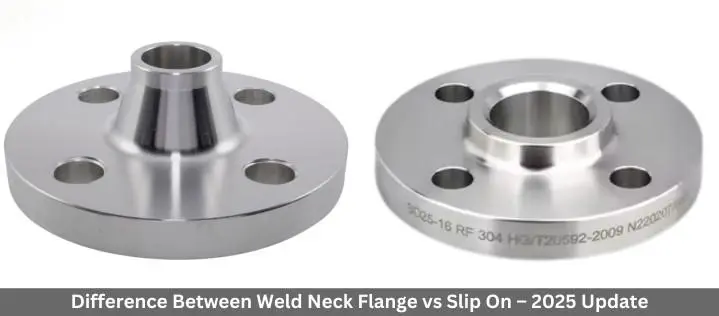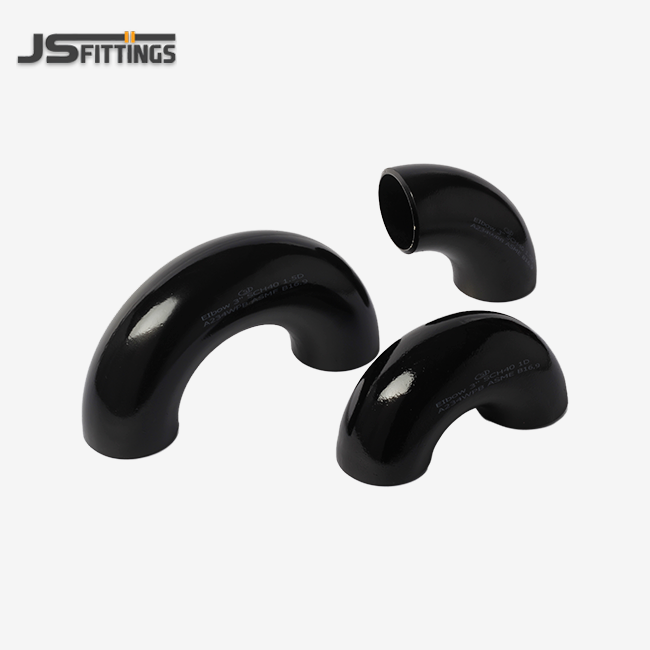Knowing the main distinctions between a weld neck pipe flange and a slip-on flange will save you a lot of time and money on your project. Weld neck flanges have a long, tapered hub that spreads stress evenly, making them great for use in high-pressure situations. Slip-on designs for carbon steel tube flanges are easier to install, but they have lower pressure ratings. The choice relies on the pressure you need, the installation limits, and what you want the product to do over time.

Understanding Flange Connection Types
For industrial pipe systems to work safely and dependably, choosing the right flange is very important. Weld neck and slip-on flanges are both important pipe couplings that are used in many different situations. However, their designs make them work in different ways.
The way stress moves through the piping system is mostly affected by the flange design. Engineers can make better choices that lower project risk and follow industry standards if they know about these discrepancies.
Flanges that can handle harsh circumstances and stay reliable for a long time are needed in modern industrial settings. Depending on the needs of your installation, each type of flange has its own set of benefits.
Weld Neck Flange Design Features
Weld neck flanges have a unique tapered hub shape that makes the transition from pipe to flange face seamless. This progressive change gets rid of stress concentration sites that could cause early failure in tough situations.
ANSI flange specifications set the standard for weld neck types, making sure that they work with parts from diverse manufacturers. With the butt weld connection method, a continuous metal path is made that stays strong even when there is a lot of pressure.
Tests show that weld neck flanges can sustain pressures of up to 2500 PSI when made of ordinary carbon steel. The raised face flange design gives you reliable sealing surfaces that stop leaks even when the temperature changes.
Some of the main design benefits are:
- Great resistance to fatigue because of a gradual change in stress
- Better at handling pressure
- Less stress buildup at the pipe-flange connection
- Improved structural dependability for important uses
Weld neck flanges are better for your needs if you need to handle high-pressure applications with less danger of needing repair.
Slip-On Flange Characteristics
The design of slip-on flanges is easier because the pipe glides into the flange bore before welding. This type of flange is a good choice for low-pressure applications because it is cheap and still meets performance standards.
When you install slip-on types, it's easier to get the flange to fit right the first time. Workers may modify the length of the pipe more quickly during assembly, which saves a lot of time and money on installation.
Tests show that regular carbon steel slip-on flanges can normally handle pressures of up to 600 PSI. Flanges normally don't need to be as thick as weld neck designs, which saves money on materials.
Some important features are:
- Lower expenses for materials at first
- Easier steps for putting things together
- More freedom when putting things together
- Good enough for applications with moderate pressure
Slip-on flanges are better choices if you need cheap solutions for moderate pressure systems that are easy to install.
Pressure Rating Comparison
Pressure ratings represent one of the most critical differences between these flange types. Weld neck flanges consistently outperform slip-on designs in high-pressure applications due to their superior structural design.
Industry testing data reveals significant performance gaps:
| Flange Type | Maximum Pressure (PSI) | Temperature Range (°F) | Fatigue Cycles |
|---|---|---|---|
| Weld Neck | 2500 | -20 to 1000 | 2,000,000+ |
| Slip-On | 600 | -20 to 650 | 500,000 |
The high pressure flange category clearly favors weld neck designs for demanding applications. Stress analysis shows that weld neck flanges distribute loads more evenly across the flange face, reducing the likelihood of bolt hole distortion.
If you need reliable performance under extreme pressure conditions, then weld neck flanges are more suitable due to their proven track record in critical applications.
Installation Methods and Requirements
The steps for installing these types of flanges are very different, which affects both the project's timeframe and the number of workers needed. Using the right methods to install flanges will make sure that the system works at its best for its whole life.
To install a weld neck flange, you need to cut and prepare the pipe very carefully. Skilled welders who can make full-penetration welds that fulfill strict quality standards are needed for the butt weld junction. It usually takes 2 to 3 hours to get ready for welding each joint.
Installing a slip-on flange gives you more options when putting things together. The pipe fitting procedure makes it easier to make adjustments to the alignment, which cuts down on installation time by around 40% compared to weld neck kinds. Both internal and external welds are still needed, though.
Important things to think about before installing are:
- Exact cutting and measuring needs
- Level of welding competence and need for certification
- Procedures for checking and controlling quality
- Setting out time for good joint preparation
If you need to install something quickly and don't want to hire a lot of expert workers, slip-on flanges are better for tasks with short deadlines.
Cost Analysis and Economic Factors
When choosing a flange, it's important to think about the cost of materials, especially for big industrial projects where material costs can have a big effect on the entire budget.
Slip-on flanges are cheaper to make at first, costing 20–30% less than weld neck flanges of the same type. These cost benefits come from the fact that less flange material is needed and the production process is easier.
But when you look at the whole cost of ownership, things get more complicated. Weld neck flanges generally give you more value over time because:
- Less maintenance needed over the life of the operation
- Less likely to have unforeseen downtime
- Longer service life in tough situations
- Less frequent inspections because of better reliability
According to a study of labor costs, slip-on flanges take around 60% of the time to install than weld neck versions do. This difference becomes important when there are hundreds of flange connections on a project.
Slip-on flanges are better for projects that need to keep costs low at first but are okay with taking on extra maintenance risks.
Application Guidelines and Industry Standards
Industry applications dictate specific flange selection criteria based on operational requirements, safety considerations, and regulatory compliance needs. Understanding these guidelines ensures appropriate flange specification for each project.
Weld neck flanges excel in demanding applications including:
- High-pressure steam systems in power generation facilities
- Chemical processing equipment handling corrosive media
- Oil and gas transmission pipelines
- Critical industrial processes requiring zero-leakage performance
Slip-on flanges prove effective in moderate-duty applications such as:
- Low-pressure water distribution systems
- HVAC equipment connections
- General industrial plumbing applications
- Non-critical process piping systems
Flange standard compliance varies by industry sector. ANSI B16.5 specifications provide comprehensive guidance for both flange types, ensuring compatibility and safety across different manufacturers.
If you need compliance with stringent safety regulations in critical applications, then weld neck flanges are more suitable due to their proven performance record.

Material Selection and Specifications
Flange material selection significantly impacts performance, cost, and service life. Both weld neck and slip-on flanges are available in various materials to match specific application requirements.
Carbon steel flange options dominate industrial applications due to their excellent strength-to-cost ratio. Standard grades include A105 for forged applications and A516 for plate-based manufacturing.
Stainless steel flange materials provide superior corrosion resistance for demanding environments. Common grades include 316L for chemical processing and 304 for general industrial applications.
Material specification considerations include:
- Corrosion resistance requirements
- Temperature exposure limits
- Mechanical strength needs
- Cost constraints and budget limitations
Testing data shows that material choice affects pressure ratings more significantly in slip-on designs due to their inherent structural limitations.
If you need maximum corrosion resistance with superior mechanical properties, then stainless steel weld neck flanges are more suitable for demanding chemical processing applications.
Quality Assurance and Testing Standards
Quality control measures ensure flange performance meets specified requirements throughout the operational life cycle. Proper testing protocols identify potential issues before installation, preventing costly failures.
Standard testing procedures include dimensional verification, material certification, and non-destructive examination. Hydrostatic testing validates pressure ratings under controlled conditions.
Weld neck flanges typically undergo more rigorous testing due to their critical application requirements. Quality standards include:
- Ultrasonic testing of hub-to-flange transitions
- Dimensional inspection per ANSI specifications
- Material traceability documentation
- Surface finish verification for sealing surfaces
Manufacturing quality affects long-term reliability significantly. Certified manufacturers maintain consistent production standards that ensure predictable performance across different production batches.
If you need guaranteed quality with comprehensive documentation for critical applications, then certified weld neck flange suppliers are more suitable for your requirements.
Conclusion
The decision between weld neck and slip-on flanges depends on the needs of the application, the budget, and the expected performance. Weld neck designs work best in high-pressure, important situations when safety and dependability are the most important things. They cost more up front, but they last longer and require less maintenance since they can handle more stress and pressure.
Slip-on flanges are a cheap way to solve problems with moderate pressure where speed of installation and budget are more important than optimal performance. Knowing these basic differences helps you make smart choices that lower project risk and get the best total cost of ownership.
FAQ
1. What is a weld neck pipe flange?
A weld neck pipe flange is a high-strength flange with a tapered hub that provides smooth stress transition, making it ideal for high-pressure and high-temperature piping systems.
2. When should I choose a weld neck flange over a slip-on flange?
Choose a weld neck flange when your system requires maximum structural integrity, superior stress distribution, and long-term reliability—especially in critical or high-pressure applications.
3. What pressure ratings can weld neck flanges handle?
Standard carbon steel weld neck flanges can typically withstand pressures up to 2500 PSI, significantly higher than slip-on types.
JS FITTINGS: Your Trusted Weld Neck Pipe Flange Manufacturer
Choosing the correct flange supplier guarantees the success of a project by providing reliable product quality and full technical assistance. For more than 40 years, JS FITTINGS has been making parts for tough industrial uses all around the world.
Our state-of-the-art production facilities follow tight quality control standards that go above and beyond what the industry needs. Four dedicated production lines make sure that products are always available and fulfill a wide range of customer needs.
Our technical staff will help you choose the best weld neck flanges for your project, whether you need them for high-performance applications or slip-on options that are less expensive and can handle moderate-duty operation.
Are you ready to talk about your unique flange needs? Our technical experts help you get the most out of your specs while making sure they meet all relevant standards. To get precise quotes and technical advice that are specific to your project, email us at admin@chinajsgj.com
References
1. American Society of Mechanical Engineers. "ASME B16.5-2020: Pipe Flanges and Flanged Fittings." New York: ASME Press, 2020.
2. Bickford, John H. "Gaskets and Gasketed Joints, Second Edition." New York: Marcel Dekker, 1998.
3. Brown, William M. "An Introduction to Piping Design, Volume 2." Houston: Gulf Publishing Company, 2005.
4. Kannappan, Sam. "Introduction to Pipe Stress Analysis." New York: John Wiley & Sons, 1986.
5. Nayyar, Mohinder L. "Piping Handbook, Eighth Edition." New York: McGraw-Hill Professional, 2019.
6. Singh, Kellogg M.W. "Design of Piping Systems, Revised Second Edition." New York: John Wiley & Sons, 1956.
_1761641000494.webp)


